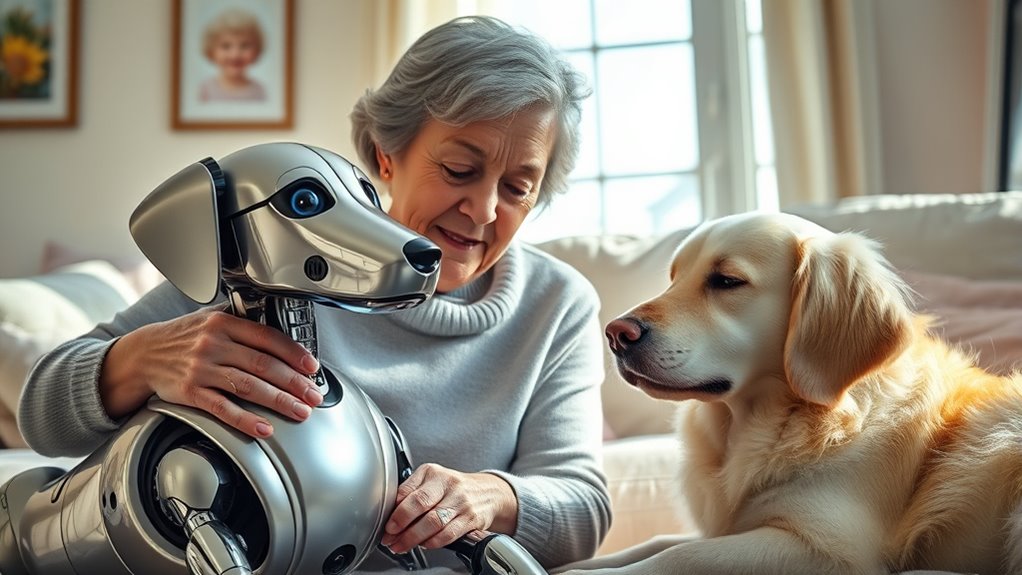Robotic companions can be a practical and low-maintenance way to ease loneliness, especially if caring for real pets isn’t possible. They respond to touch and voice, providing comfort and familiarity, but they lack the genuine emotional connection that pet therapy offers through real animals. If you’re seeking authentic bonds and emotional growth, pet therapy tends to be more effective. Stay with us to discover how each option compares for your emotional wellbeing.
Key Takeaways
- Pet therapy offers genuine emotional bonds and organic interactions that deeply reduce loneliness and foster resilience.
- Robotic companions provide consistent, low-maintenance comfort, especially for those unable to care for live animals.
- The authenticity of emotional connection in pet therapy often results in stronger feelings of companionship than robotic responses.
- Robotic devices are ideal in environments where live pets are impractical or prohibited, ensuring continuous companionship.
- Ultimately, the effectiveness depends on individual needs; pet therapy offers deeper emotional fulfillment, while robots provide reliable routine-based comfort.

As technology advances, robotic companions are becoming a popular alternative to traditional pet therapy, especially for those who can’t care for live animals. You might find that these robots offer a unique way to combat loneliness without the responsibilities or unpredictability of real pets. Unlike living animals, robotic companions don’t require feeding, grooming, or veterinary care. They’re designed to mimic the behaviors and emotional responses of animals, providing comfort and companionship without the logistical concerns. This makes them especially appealing for people with allergies, mobility issues, or those living in environments where caring for a live pet isn’t feasible.
Robotic companions offer allergy-friendly, low-maintenance comfort and companionship without the responsibilities of caring for a live pet.
You could find that robotic companions are consistently available and don’t suffer from mood swings or health problems, which ensures a steady source of comfort. They can be programmed to respond to your touch, voice, or even specific routines, creating a sense of familiarity and routine that helps reduce feelings of isolation. Some models even learn your preferences over time, becoming more personalized and intuitive, which enhances the feeling of genuine companionship. Because of their programmable nature, robotic companions can be tailored to suit your emotional needs, offering different levels of interaction, from simple presence to active engagement.
However, despite these advantages, robotic companions might lack the genuine emotional connection that comes naturally with real animals. Pets can sense your emotions and respond in ways that foster deep bonds—licks, cuddles, or just their presence in quiet moments. These organic interactions can trigger biological responses, like the release of oxytocin, which boosts your mood and reduces stress. Robots, on the other hand, simulate these behaviors but don’t truly experience emotions. So, while they can provide comfort, they might not evoke the same warmth or authenticity that a live pet offers.
You should also consider the emotional impact of caring for a real animal. Pet therapy often involves the act of caring itself, which can give you purpose and a sense of responsibility. The unconditional love and companionship of a pet can foster emotional growth and resilience, which robotic companions can’t replicate fully. Yet, for individuals unable to provide the physical care or handle the unpredictability of live animals, robotic companions serve as a reliable, low-maintenance alternative. They can fill a void, provide consistent companionship, and reduce loneliness, especially in settings like hospitals or nursing homes where live animals might not be permitted or practical.
In the end, whether robotic companions ease loneliness better than pet therapy depends on your personal needs and circumstances. While robots can offer steady, customizable companionship, they may fall short of the emotional depth that a living pet provides. Both options have their place, and understanding your specific situation will help you decide which one can best serve your emotional well-being.
Frequently Asked Questions
How Do Costs Compare Between Robotic Companions and Pet Therapy?
Robotic companions generally cost more upfront, often ranging from a few hundred to several thousand dollars, but they don’t require ongoing expenses like food, vet visits, or grooming. Pet therapy, on the other hand, is usually free or involves minimal costs, mainly for transportation or supplies. Over time, robotic devices might be more expensive, but they also offer consistent, maintenance-free interaction that some find worth the investment.
Are Robotic Companions Suitable for All Age Groups?
Robotic companions are suitable for many age groups, especially seniors, as studies show 90% of elderly users find them engaging. You’ll find that these devices offer companionship without the responsibilities of caring for a living pet. Young children benefit from interactive features, while adults may appreciate their consistent presence. However, individual needs vary, so it’s essential to take into account personal preferences and tech comfort levels for the best experience.
What Are the Long-Term Emotional Impacts of Robotic Versus Real Pets?
Robotic pets may provide comfort, but they often lack the emotional depth of real pets, which can lead to a sense of emptiness over time. You might feel less attachment and reduced social interaction with robots, whereas real pets foster genuine bonds, boost your mood, and encourage activity. Long-term, real pets tend to offer more meaningful emotional support, helping you feel truly connected and less lonely.
Can Robotic Companions Fully Replace Human Interaction?
Sure, robotic companions can fool you into thinking you’re chatting with a real friend, but they can’t replace the warmth, unpredictability, and genuine connection humans offer. You might enjoy a conversation with a machine, but when it comes to true understanding and emotional support, nothing beats genuine human interaction. So, while robots can fill a gap temporarily, they’ll never truly replace the messy, beautiful complexity of real human relationships.
How Do Cultural Attitudes Influence Acceptance of Robotic Versus Pet Therapy?
Cultural attitudes greatly influence how you accept robotic versus pet therapy. In some societies, technology is embraced, making robotic companions more readily accepted for companionship. Others value traditional human-animal bonds, favoring pet therapy. If your culture views animals as family, you may prefer pet therapy. Conversely, if technological innovation is celebrated, robotic companions might seem more suitable. Your cultural perspective shapes your comfort and openness to these different forms of alleviating loneliness.
Conclusion
In the battle against loneliness, both robotic companions and pet therapy pack a punch, but it’s up to you to choose your champion. Robotic friends might seem like science fiction come true, offering endless entertainment, while real pets bring unpredictable love that no machine can match. Ultimately, the best solution depends on your needs—just remember, whether metal or fur, these companions can turn loneliness into a distant memory faster than you can blink.









